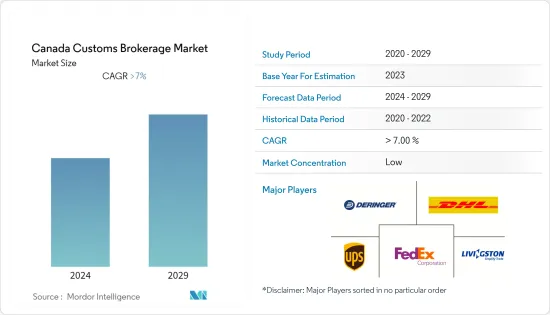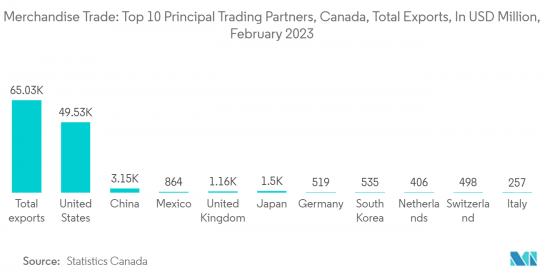PUBLISHER: Mordor Intelligence | PRODUCT CODE: 1407076

PUBLISHER: Mordor Intelligence | PRODUCT CODE: 1407076
Canada Customs Brokerage - Market Share Analysis, Industry Trends & Statistics, Growth Forecasts 2024 - 2029

The Canada Customs Brokerage Market is valued at about USD 450 Million in the current year and poised to grow at a CAGR of over 7% during the forecast period. The market is driven by the increase in trade in the region. Furthermore, the market is driven by the increasing demand for custom brokers because of the complexity of the trading systems.
Key Highlights
- Many people identify customs brokers with importing, although their skills and particular knowledge can be beneficial to exporters in today's complicated and frequently unpredictable trade climate. Aside from multiple new trade agreements, there have been the disruptive impacts of the global pandemic and an increasing tendency by the US government to utilise trade agreements aggressively rather than as a tool to encourage international trade. As a result, the global trade environment has shifted from one that was formerly very predictable to one that is becoming increasingly unpredictable. In actuality, a broker's function is to facilitate trade and assist exporters in risk management.
- The Canada Border Services Agency (CBSA) has also adopted the Canadian Export Reporting System (CERS), a web-based, self-service site, and no longer accepts paper-based export declarations. With this mechanism in place, the Canadian government may easily audit export declarations. If exporters do not meet all of the rules, they are more likely to face financial penalties. A customs broker can help exporters ensure they are doing everything correctly to avoid these penalties. A list of brokers and specialists is available from the Canadian Association of Importers and Exporters (IE Canada). The Canadian Society of Customs Brokers (CSCB) maintains the Importers Network, which also assists to help exporters and importers choose what type of broker or specialist they may want. Another organisation that provides a list of brokers and specialists is the Canadian International Freight Forwarders Association (CIFFA). Not all brokers are created equal. Some do a little bit of everything, while others specialise in one area, such as goods.
- The Covid-19 epidemic continues to have an impact on global trade flows and economic growth in 2022 and is expected to continue into 2023. The third year of Covid-19, along with the Ukraine/Russia conflict, has increased geopolitical instability, potentially impeding global economic recovery. The World Trade Organisation (WTO) predicts a 3% increase in merchandise trade volume in 2022, down from a previous prediction of 4.7% and 3.4% in 2023. Commodity prices have risen as a result of the Russia/Ukraine situation, which has had the most immediate economic impact. Russia and Ukraine are significant suppliers of critical items such as food, electricity, and fertilisers. This has had a global impact, particularly in low-income nations where food makes up a major portion of household income. In Canada, the top 3 exports are crude petroleum, cars and refined petroleum with the top 3 imports being cars; car parts and accessories; and trucks.
- The United States' decision to reduce Section 301 tariffs (Trade Act of 1974 (U.S.)) on over 100 Chinese-made medical items may have an impact on Canadian enterprises that sell competing goods to the United States. The customs brokerage industry is highly competitive, with many brokers operating, particularly near borders. The major players, however, control a sizable piece of the market. Companies that offer customs brokerage services are investing in R&D to acquire a market advantage. R&D spending is likely to rise during the predicted period as demand develops for streamlined and more efficient customs-clearing systems with quick turnaround times.
Canada Customs Brokerage Market Trends
Increasing International Trade Driving the Market
- Canada's merchandise exports fell by 1.2% in December 2022, owing primarily to weaker exports of petroleum items. Meanwhile, imports fell 1.3%, owing primarily to fewer consumer goods imports. As a result, Canada's global merchandise trade imbalance fell from USD 219 million in November to USD 160 million in December. These tight trade balances are within the normal range for monthly revisions to imports and exports. Total exports declined 1.2% in December 2022 to USD 63.0 billion, the lowest level since February 2022. Declines were noted in 7 of the 11 product categories, with energy exports leading the way. Exports excluding energy goods, on the other hand, increased by 0.8%. Total exports increased in real (or volume) terms as well, rising 0.9% in December 2022.
- Imports from nations other than the United States fell 3.8% in December 2022, the second monthly reduction in a row. Imports from Switzerland (pharmaceutical products), Mexico (various products), and the Netherlands (motor petrol) were the driving forces behind the declines. In December, exports to nations other than the United States fell 4.5%. Exports to China (oilseeds and canola) and the United Kingdom (gold) fell the most. Canada's trade deficit with non-US countries fell from USD 7.3 billion in November to USD 7.1 billion in December. Exports to the United States fell 0.1% in December, while imports increased 0.2%. As a result, the merchandise trade surplus with the United States shrank for the seventh consecutive month, falling from USD 7.1 billion in November to USD 7.0 billion in December 2022.

Increasing Cross-Border Road Freight Driving the Market
- Although there is talk of a future recession, and inflation has reached levels not seen since 1983, the boom in cross-border freight continues. According to the US Bureau of Transportation Statistics, trucks moved USD 35.6 billion in freight in both directions across the Canada-US border in April. In April 2022, another USD 44 billion was transported by truck across the US-Mexico border. Ontario border crossings with Detroit and Port Huron, Michigan, accounted for USD 10 billion and USD 6.2 billion, respectively, of the total. Mexico's Laredo, Texas, crossing remained the busiest land port overall, with USD 19.6 billion in truck freight.
- Computers and parts (USD 14.9 billion), electrical machinery (USD 11.6 billion), and automobiles and parts (USD 10.8 billion) were the top three items transported by truck over Canada, the United States, and Mexico's borders. When trucks, trains, aircraft, ships, and pipelines are included, total freight transit between Canada and the United States was USD 69.1 billion, a 31.2% increase over April 2021. Oil and gas accounted for 99% of items moved by pipelines, with the value of that oil increasing by 64.9% over the same month in 2021. According to data from the Public Health Agency of Canada, customs inspectors at the Canada-US border processed 461,150 truck drivers in April 2022, up from 453,789 in April 2021.
- Video intelligence technologies are assisting in the improvement of driving practises while also increasing accountability. Artificial intelligence is being utilised to process video footage in real time and trigger event recordings. High-resolution video documentation can give a clear source of truth in the event of an accident or incident, reducing litigation expenses and difficulties. AI and machine learning are being used to speed up data retrieval, saving fleets from having to examine hours of film. While Canada's provinces catch up on MELT, the driving public and fleet owners can take comfort in knowing that technology is helping to make driving easier, more straightforward, and safer than ever before.
Canada Customs Brokerage Industry Overview
The market for Customs Brokerage in Canada is fragmented in nature. With a large number of customs brokers operating in the market, the competition is high. The top players in the market include United Parcel Service, FedEx Corporation, Livingston, A.N Deringer, DHL Group, etc.
Additional Benefits:
- The market estimate (ME) sheet in Excel format
- 3 months of analyst support
TABLE OF CONTENTS
1 INTRODUCTION
- 1.1 Study Assumptions
- 1.2 Scope of the Study
2 RESEARCH METHODOLOGY
- 2.1 Analysis Method
- 2.2 Research Phases
3 EXECUTIVE SUMMARY
4 MARKET INSIGHTS DYNAMICS
- 4.1 Current Market Scenario
- 4.2 Market Overview
- 4.3 Market Dynamics
- 4.3.1 Drivers
- 4.3.2 Restraints
- 4.3.3 Opportunities
- 4.4 Value Chain / Supply Chain Analysis
- 4.5 Porters Five Forces Analysis
- 4.5.1 Threat of New Entrants
- 4.5.2 Bargaining Power of Buyers/Consumers
- 4.5.3 Bargaining Power of Suppliers
- 4.5.4 Threat of Substitute Products
- 4.5.5 Intensity of Competitive Rivalry
- 4.6 Government Initiatives and Regulations
- 4.7 Impact of COVID-19 on the Market
- 4.8 Insights on Imports and Custom Brokerage Services
- 4.9 Brief on Customs Brokerage as a Freight Forwarding Function
- 4.10 Overview of Customs Pricing
- 4.11 Insights on Customs Brokerage Services by End-user Industry
5 MARKET SEGMENTATION
- 5.1 By Mode Of Transport
- 5.1.1 Sea
- 5.1.2 Air
- 5.1.3 Cross-Border Land Transport
6 MARKET OVERVIEW FOR SOLUTIONS ALLIED TO CUSTOMS BROKERAGE SERVICE
- 6.1 Software
- 6.2 Consulting
- 6.3 Contract Logistics-based Customs Brokerage
- 6.4 Other Related Value-added Services
7 COMPETITIVE LANDSCAPE
- 7.1 Market Concentration Overview
- 7.2 Company Profiles
- 7.2.1 DHL Group Logistics
- 7.2.2 Livingston
- 7.2.3 United Parcel Services
- 7.2.4 A.N Deringer
- 7.2.5 FedEx Corporation
- 7.2.6 Universal Logistics
- 7.2.7 Argo Customs
- 7.2.8 DB Schenker
- 7.2.9 Kuehne and Nagel
- 7.2.10 World Wide Customs Brokers Limited*
8 MARKET OPPORTUNITIES AND FUTURE TRENDS
9 APPENDIX
- 9.1 Macroeconomic Indicators (GDP Distribution by Activity, Contribution of Transport/Courier Industry to Economy)
- 9.2 Insights on capital flow
- 9.3 Exports and Import Statistics




